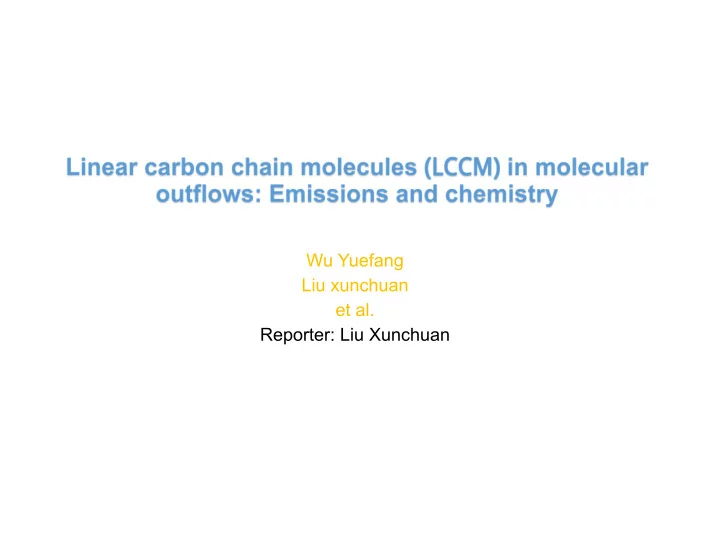

Wu Yuefang Liu xunchuan et al. Reporter: Liu Xunchuan
Preface: brief introduction to our work related to Effelsberg 100m Ammonia cores in high mass star formation regions A&A 450 607 sources: Coutours 35 water masers without UCHII or YSOs NH3 observed lines: NH3 Background MSX band A detection: 17 detected and mapped. Triangle IRAS Group I (11 sources) NH3 core closed to far/mid-infred center but no 6 cm free-free emission high mass protostellar candidates ? Group II (4 sources) NH3 core associated with far/mid-infred pre-protostellar?
Preface: brief introduction to our work related to Effelsberg 100m The Discovery of a Massive SCUBA Core with both Inflow and Outflow Motions HCN ApJ 628 L57 JCMT NH3 (1, 1) core name Effelsberg 18354-0649 RA 18:38:08.10 DEC −6:46:52.17 HCN 850 um SMA JCMT
Preface: brief introduction to our work related to Effelsberg 100m NH3 observation towards Planck Cold Clumps ---- Newly observed in 2018.01.29 50 PGCC sources single point mode S14 receiver Low resolution mode Dv: 0.5 km/s Thanks for help of MPIfR staffs Alex Henkel ...
LCCM LCCMs are important components of interstellar gas. Region Ref First detection: Sgr 2 Turner 1971 M aterial infall Friesen et al. 2013 D iffuse clouds Mitchell & Huntress 1979; Lucas & Liszt 2000;... PDR Teyssier et al. 2004; Gratier et al. 2013... LCCMs in different stages Stage Character Example Very abundant, including S - and O -bearing LCCM s. TMC1, L1521B, L1521E, D ark and quiescent cores Possitive correlation L1495B, ... between S- and N-bearing LCCMs. Lower abundance. But still possitive correlation Dense and warm cores L1527, IRAS15398-3359 ... between S- and N-bearing LCCMs. C4H (WCCC).
LCCM Early cores Suzuki, Hiroko, 1992 Column density of S-bearing and N-bearing species : Good positive correlation Indicating their similar chemistry
LCCM Star formation regions: WCCC When the gas is heated to 30 K, CH 4 is evaporated and reacts with C+ to produce hydrocarbon ions, which further form LCCMs and result in WCCC (Sakai et al. 2009). Abundance enhanced: C4H, CO2, ... N-/S-bearing LCCMs decrease while possitive correlation held. Sakai, N, 2008
LCCM To further study emissions and chemistry in the outflow phase of star formation regions , a survey for LCCMs in molecular outflows was proposed. Sources choosed to be observed with TMRT 65m Dist (pc) T Dust (K) Sources Ra Dec Stage L1489 04:04:47.5 +26:19:42 140 15.36 outflow IRAS 20582 20:57:10.6 +77:35:46 200 13.7 outflow L1221 22:28:02.7 +69:01:13 200 20.43 outflow L1251A 22:30:35.0 +75:14:00 330 12.49 outflow LupusI-1 15:43:01.68 -34:09:08.9 155 13.96 outflow LupusI-2 15:44:59.8 -34:17:09 155 11.63 early stage LupusI-5 15:45:03.80 -34:17:57.3 155 11.11 early stage LupusI-6 15:42:52.4 -34:07:54 155 10.08 early stage LupusI-7/8/9 15:42:44.06 -34:08:30.4 155 10.2 early stage LupusI-11 15:45:25.10 -34:24:01.8 155 11.61 early stage
LCCM Observring with TMRT 65m Location: Tianma town, Shanghai, China Ku band Mode 22: 3 bands, each splited into 8 floated windows. 24 windows in total. 23.4 MHz width for each window (500 km/s). velocity resoution: 0.02~0.03 km/s. Jan., Mar. of 2016; Sept., Dec. of 2017;
LCCM Observring with TMRT 65m
LCCM Observring with TMRT 65m Early cores high abundance Possitive correlation Outflow sources lower abundance except Lup 1-1. group I Possitive correlation group II Negative correlation
LCCM L1489: New found WCCC Although no detection of HCO 2+ . CO 2 was obtained via 4.67 μ m CO with UKIRT by Chiar et al. (1998). PMO 13.7m, TMRT 3mm band Ku band
LCCM Group II I20582 L1221 L1251A dust temperature: 13.70 K 20.43 K 12.49 K outflow ages: 1E5 yr 5E4 yr 7E4 yr All associated with collimated molecular outflows, jets or HH objects. These show that shock ionization may lead the reducing the core gas and most linear carbon molecules (N-bearing). However, ionization increase SII and make C3S increasing. Shock induced chemistry should instead of cold dark cloud chemistry and WCCC in these three sources. We name it as shocked carbon- chain chemistry ( SCCC ) 1. Different from the sources with early cold core chemistry and WCCC, the column densities of C3S of SCCC cores exceed those of HC7N . 2. The sources are with molecular outflows and infrared/optical jets. The dynamic time scales are about 5 × 10 4 to 10 5 yr. 3. [SII] is abundant and produced in shocked ionisation gas.
LCCM Gas-Grain Chemical model of SCCC n(H2) = 10 5 cm -3 , A V = 5 mag, ionization after J-shock. γ = 1.3 × 10 −17 s −1 , σ g = 0.03 μ , b = 0.1, V shock = 25 km/s T(-->1E5 yr) = 10 K, T(1E5-->1.5E5 yr) = 10-->40 K. f s = 10 −9 Based on UMIST chemical network
LCCM Further Search with PMO 13.7m in 3mm include C2H N2H+ HC3N c-C3H2 C4H C2S 100 outflows sources observed (rms~25 mK). 11 sources detected with C4H. 5 sources detected with C2S. 2 sources detected both C4H and C2S. (03301+3257; HH211) c-C3H2 HC3N C4H C2S
LCCM Further Search with Effelsberg 100m in k band HC3N 18196.279 c-C3H2 18343.143 30 outflow sources observed, 12 detecton of C3S. HC5N 18638.611 C4H Four SCCC candidates: 19015.143 L1251_1, C3S L1251_3, 23122.983 03301+3057, 20353+6742 HC7N 23687.897 NH3 23694.495
LCCM Future work Search more WCCC/SCCC sources with different telescpes at differernt bands Build a more detailed model about WCCC/SCCC Choose some typical SCCC sources to do high resolution observation
Thanks
Recommend
More recommend